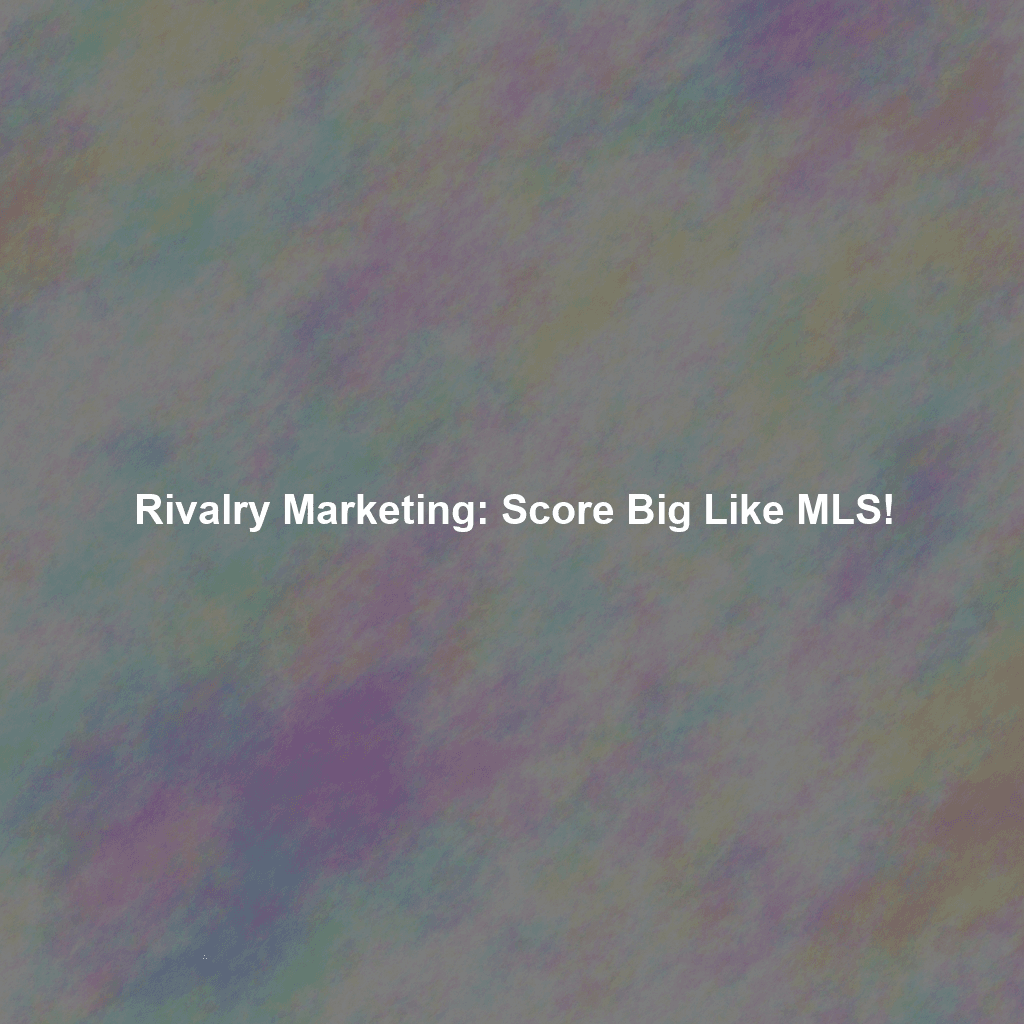Why Rivalry Marketing Works: Tapping into Human Nature
At its core, rivalry marketing is about tapping into the fundamental human desire for competition and belonging. Think back to any significant rivalry – Coke vs. Pepsi, Apple vs. Android, Lakers vs. Celtics. These aren’t just about products or sports teams; they represent identities, values, and a chance to belong to something bigger than oneself. Rivalries create:
- Increased Engagement: People are more likely to pay attention when there’s something at stake.
- Emotional Connection: Strong feelings, whether positive or negative, create memorable experiences.
- Word-of-Mouth Marketing: Rivalries naturally generate conversation and buzz.
- Brand Loyalty: Choosing a side fosters a deeper connection to a particular brand.
Professor Jonah Berger, in his book “Contagious: Why Things Catch On,” highlights the importance of social currency – making people feel like insiders and giving them something to talk about. Rivalries inherently provide that social currency. (Source: JonahBerger.com)
The MLS Playbook: How Soccer Scores with Rivalries
MLS has expertly cultivated rivalries to become a core element of its marketing strategy. Here are some key techniques they employ:
Designated Rivalry Games: The Stage is Set
MLS schedules are strategically designed to highlight key rivalry matches, often placing them in prime time slots and promoting them heavily. These aren’t just regular games; they’re events. Examples include:
- Seattle Sounders vs. Portland Timbers (The Cascadia Cup): This rivalry transcends state lines, fueled by history and passionate fan bases. MLS heavily promotes these matches with dedicated hashtags, pre-game shows, and special ticket packages.
- LA Galaxy vs. LAFC (El Tráfico): The battle for Los Angeles supremacy. The name itself (“The Traffic”) cleverly plays on LA’s notorious traffic jams, adding a local, relatable touch.
- Toronto FC vs. Montreal Impact (Canadian Classique): A national rivalry representing distinct Canadian cultures.
Actionable Insight: Identify key competitors in your industry and create “designated” moments – product launches, special events, or campaigns – to highlight the competitive landscape.
Embracing the Trash Talk: Letting the Rivalry Breathe
MLS allows (and even encourages) players and coaches to engage in playful trash talk. This adds fuel to the fire and keeps fans engaged. Remember Zlatan Ibrahimović’s infamous comments about LAFC before joining the LA Galaxy? That created instant buzz and heightened anticipation for El Tráfico. While always ensuring it remains respectful, trash talk generates headlines and adds personality to the rivalry.
Actionable Insight: Don’t be afraid to inject some personality into your brand. If appropriate for your industry, allow your team to express their competitive spirit (within ethical and professional boundaries, of course!). Consider using humor to acknowledge your competitors, fostering a lighthearted sense of rivalry.
Fan Involvement: Making it Personal
MLS actively involves fans in the rivalry narrative. They encourage fans to create chants, design banners, and participate in pre-game rituals that amplify the atmosphere and make the rivalry a shared experience. Social media contests and polls asking fans to predict the outcome of rivalry games further deepen their engagement.
Actionable Insight: Encourage user-generated content related to the rivalry. Run contests asking customers to share their experiences, create memes, or express their loyalty. Create online forums or social media groups where fans can connect and debate.
Leveraging Social Media: Amplifying the Narrative
MLS teams and the league itself use social media to fuel the rivalry narrative. They share highlights of past matches, post interviews with players hyping up the game, and create engaging content that plays on the history and emotions associated with the rivalry. Clever use of hashtags helps to consolidate the conversation and make it easier for fans to follow along.
Actionable Insight: Create dedicated hashtags for your rivalries. Use social media to share engaging content that highlights the competitive landscape, celebrates your strengths, and acknowledges your competitors (respectfully, of course!). Run polls, quizzes, and Q&A sessions to stimulate conversation and get fans involved.
Beyond the Game: Community Engagement
Many MLS teams use their rivalry to promote community initiatives. For example, opposing teams might partner on charitable projects or participate in joint community events. This shows that even amidst competition, there’s a shared commitment to the community, softening the edges of the rivalry and creating a more positive image for both teams.
Actionable Insight: Find opportunities to collaborate with your competitors on initiatives that benefit the community or your industry as a whole. This can help to build goodwill and demonstrate your commitment to something bigger than just winning.
Rivalry Marketing Beyond the Pitch: Adaptable Strategies for Any Industry
The principles of rivalry marketing are not limited to sports. Here’s how you can adapt them for your industry:
Identifying Your Rival: Knowing Your Competition
The first step is to identify your genuine rivals. These aren’t just any competitors; they are the ones that customers consistently compare you to. Consider factors like:
- Target Audience: Do you both target the same customer base?
- Product/Service Offering: Do you offer similar products or services?
- Brand Positioning: Do you compete on price, quality, or innovation?
Example: In the coffee industry, Starbucks and Dunkin’ are clear rivals, competing for the morning coffee crowd. In the cloud storage space, Google Drive, Dropbox, and Microsoft OneDrive are locked in a constant battle for users.
Crafting Your Narrative: Telling a Compelling Story
Every good rivalry has a compelling narrative. Develop a story that highlights the key differences between you and your rival. Are you the innovative disruptor challenging the established leader? Are you the value-focused alternative to the premium brand? Define your unique selling proposition and use it to create a compelling narrative that resonates with your target audience.
Example: Avis famously positioned itself as the “We Try Harder” alternative to Hertz, embracing its number-two status and turning it into a strength. (Source: “Positioning: The Battle for Your Mind” by Al Ries and Jack Trout)
Ethical Considerations: Playing Fair
Rivalry marketing should always be ethical and respectful. Avoid:
- False Advertising: Don’t make false or misleading claims about your competitor.
- Disparagement: Don’t engage in personal attacks or try to damage your competitor’s reputation.
- Copyright Infringement: Don’t use your competitor’s trademarks or copyrighted material without permission.
Focus on highlighting your own strengths and differentiating factors, rather than tearing down your competition. Remember, a healthy rivalry benefits everyone by driving innovation and improving the overall customer experience.
Content Marketing Opportunities: Fueling the Fire with Content
Rivalries provide endless opportunities for engaging content. Consider creating:
- Comparison Guides: Objectively compare your product or service to your competitor’s.
- Infographics: Visually highlight the key differences between you and your rival.
- Blog Posts: Share your perspective on industry trends and challenges, subtly contrasting your approach with your competitor’s.
- Videos: Create engaging videos that showcase your product’s unique features and benefits, addressing common concerns or misconceptions about your competitor’s offerings.
Actionable Insight: Create a blog post titled ” (Your Brand) vs. (Competitor Brand): A Head-to-Head Comparison.” This provides valuable information to customers researching their options while also highlighting your key differentiators.
Targeted Promotions: Winning Over the Competition’s Customers
Use targeted promotions to attract your competitor’s customers. Offer a special discount for customers who switch from your competitor, or create a bundle that addresses a common pain point associated with their offering. Make sure your promotions are aligned with your overall brand strategy and value proposition.
Example: A new CRM software company might offer a free data migration service for customers switching from Salesforce, directly addressing a common barrier to adoption.
Building a Community: Fostering Loyalty
Create a strong sense of community around your brand. Encourage customers to connect with each other, share their experiences, and become advocates for your product or service. This can be achieved through online forums, social media groups, or even in-person events. A strong community creates a sense of belonging and makes it more difficult for customers to switch to a competitor.
Real-World Examples of Rivalry Marketing Success
Apple vs. Android: The Mobile OS Wars
The rivalry between Apple’s iOS and Google’s Android is one of the most well-known examples of rivalry marketing. Each company has cultivated a strong brand identity and a loyal fan base, leading to intense debates and passionate advocacy for their respective platforms. This rivalry has fueled innovation and driven both companies to constantly improve their products.
Coke vs. Pepsi: The Cola Giants
The “Cola Wars” are a classic example of a long-standing rivalry. Coke and Pepsi have battled for market share for decades, using aggressive advertising campaigns and celebrity endorsements to win over consumers. This rivalry has created a strong awareness of both brands and kept them top-of-mind for consumers. (Source: Coca-Cola Company and PepsiCo)
McDonald’s vs. Burger King: The Fast Food Face-Off
McDonald’s and Burger King have been locked in a battle for fast-food supremacy for decades. Each company uses different strategies to attract customers, with McDonald’s focusing on consistency and convenience, while Burger King emphasizes customization and bold flavors. This rivalry has created a dynamic and competitive fast-food market, benefiting consumers with a wider range of choices.
Conclusion: Embracing the Competitive Spirit
Rivalry marketing, when executed ethically and strategically, can be a powerful tool for driving engagement, boosting brand awareness, and fostering customer loyalty. By learning from the successes of MLS and other iconic rivalries, you can adapt these principles to your own industry and harness the power of competition to achieve your marketing goals. Remember to focus on building a strong brand identity, crafting a compelling narrative, and engaging your audience in a meaningful way.
 Skip to content
Skip to content

